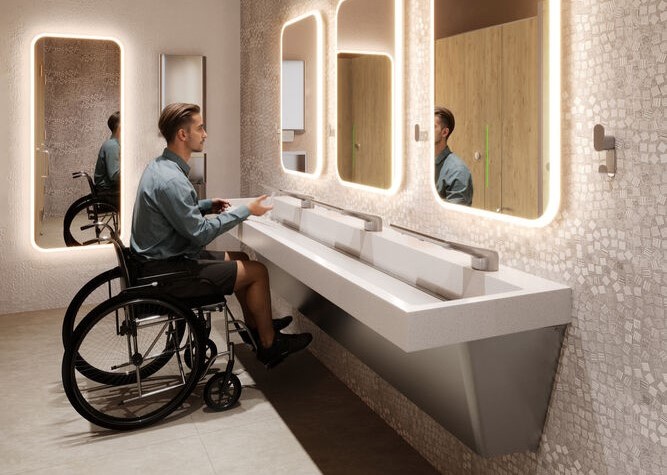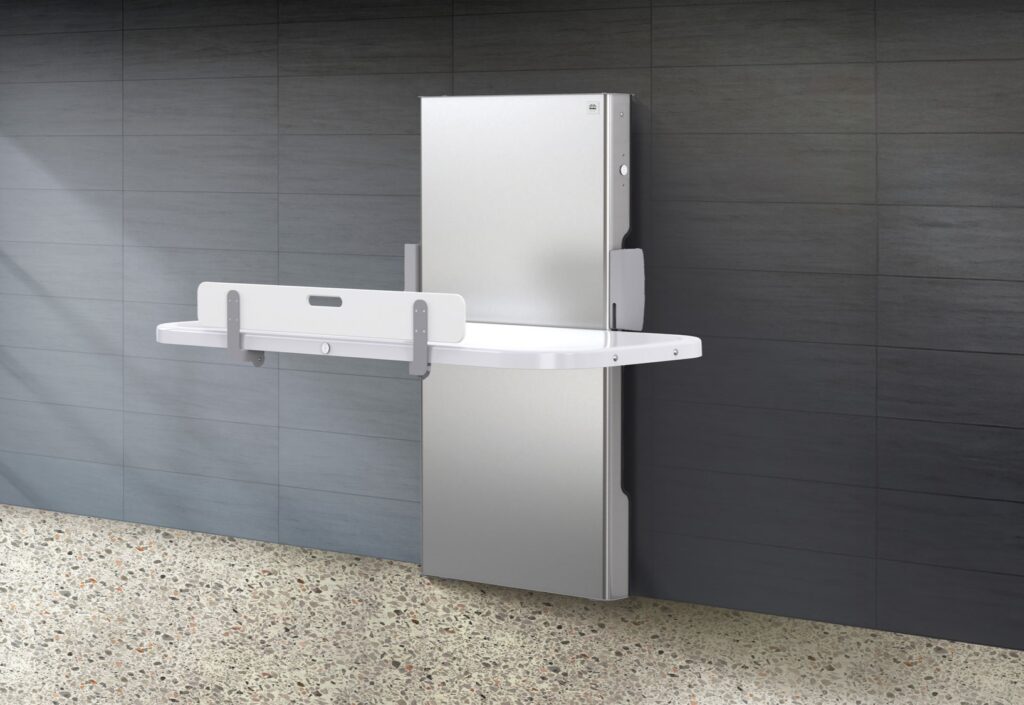Public restrooms are more than functional spaces; they are touchpoints that shape perceptions of inclusivity, accessibility, and overall user experience for occupants and visitors. Facilities managers and designers increasingly recognize that restroom design can either remove or reinforce barriers for people of diverse ages, abilities, and backgrounds. From layout considerations to product selection, inclusive strategies help ensure that restrooms serve everyone equitably.

Privacy and Layouts that Welcome All
Privacy remains a top concern in public restrooms. According to the 2025 Healthy Handwashing Survey, 72% of Americans feel that stalls don’t provide sufficient privacy, with many preferring partitions that extend floor-to-ceiling and eliminate sightline gaps.
One growing solution is the all-gender restroom model, inspired by European designs, which combines fully enclosed stalls arranged around a shared handwashing area. This configuration supports washroom traffic efficiency while ensuring privacy. Wider doorways, accessible turning radiuses, and family-friendly layouts with stroller space can further enhance usability for all patrons.
Beyond layout, design details matter. Sound-proofing materials help maintain discretion, while occupancy indicators reduce anxiety by clearly signaling stall availability. These elements foster comfort and confidence for users who may otherwise feel uneasy in public washroom facilities.
Universal Changing Tables: Expanding Accessibility
For individuals with mobility challenges, older adults, or caregivers assisting with toileting needs, Universal Changing Tables (UCTs) are critical features in public restrooms. These Americans with Disabilities Act (ADA)-compliant fixtures, which adjust in height and support weights up to 500 pounds, provide a safe and hygienic surface for personal care.

The International Building Code (IBC) now requires adult changing stations in many public venues, signaling their growing importance in commercial and institutional restrooms. By incorporating UCTs, facilities not only comply with regulations but also demonstrate a commitment to inclusivity and support for caregivers and users with mobility needs in high-traffic locations such as airports, stadiums, and cultural venues.
Menstrual Product Dispensers: Addressing Equity and Period Poverty
Period poverty—defined as the lack of access to affordable menstrual supplies—affects roughly 500 million people worldwide each month. In the United States, nearly 30 states, along with the District of Columbia, have passed legislation requiring free menstrual products in schools and, in some cases, universities and other public facilities.
Installing cost-effective, hygienic menstrual product dispensers in public restrooms—with free access—addresses both health and equity concerns. Surveys show that 84% of students report they have either missed class themselves or know someone who has due to lack of menstrual products.
For facilities managers, providing these supplies reduces stress and stigma, and helps institutions foster supportive and accommodating restroom environments.
Mirrors and Washroom Accessories: Enhancing Usability and ADA Compliance
While often overlooked, mirror placement can significantly impact inclusivity. ADA guidelines recommend mirrors no higher than 40 inches above the floor for users seated in wheelchairs. Offering a combination of vertical, horizontal, and full-length mirrors accommodates both seated and standing users. These flexible arrangements also serve caregivers, parents with children, and people of different statures, creating a more equitable restroom experience.
Washroom accessories and touchless fixtures also improve accessibility along with hygiene. Grab bars, dual-height sinks, and touchless handwashing and drying fixtures not only support ADA compliance but also align with user expectations for safer, more hygienic restrooms. According to the Healthy Handwashing Survey, nearly 80% of Americans consider touchless fixtures essential in public restrooms.
Facilities are also turning to all-in-one handwashing systems that integrate touch-free soap, water, and drying functions into a single unit. These designs minimize splashing, reduce slip hazards, streamline maintenance, and create a seamless and intuitive user experience.
Creating a Welcoming Environment
Inclusive restrooms go beyond code compliance; they convey respect and belonging. Incorporating biophilic elements such as natural colors and finishes, soft lighting, and greenery can reduce stress and make spaces feel less institutional.

Durable, easy-to-clean washbasin materials like non-porous and hygienic natural quartz and solid surface balance natural-looking aesthetics with performance while ensuring long-term maintainability.
Regularly stocking essentials—soap, towels, and menstrual products—remains equally critical. When surveyed about what improvement they most want in public restrooms, Americans overwhelmingly cited “cleaning them more regularly and keeping them better stocked.”
A Commitment to Inclusion
Designing inclusive restrooms requires a holistic approach that includes privacy, accessibility, and hygiene. Features like full-height partitions, UCTs, menstrual product dispensers, thoughtful mirror placement, and touchless fixtures demonstrate a facility’s commitment to creating a welcoming and accessible restroom experience for all individuals.
Ultimately, inclusivity in restroom design is not simply about meeting regulations—it’s about creating environments that welcome every person who walks through the door. For facilities managers, embracing these strategies represents both a responsibility and an opportunity: to align the built environment with values of equity, accessibility, and respect.
Kris Alderson, MBA, LEED AP, is the senior marketing manager for Bradley Company, the 100-year-old global manufacturer of commercial plumbing fixtures, washroom accessories, emergency safety fixtures, and electric tankless water heaters, now a division of Watts Water Technologies. For more information on the Healthy Handwashing Survey, check out bradleycorp.com/handwashing.
